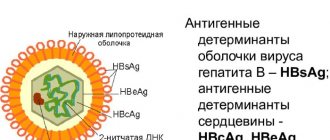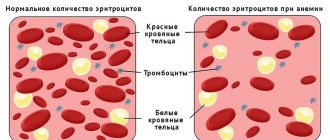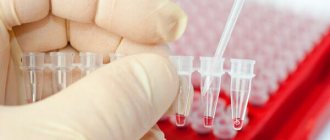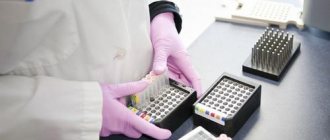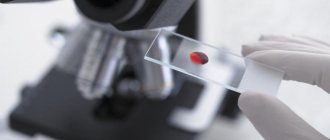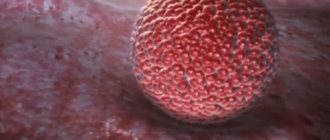Characteristics and types of tumor markers
Tumor markers are a large group of biomolecules that differ in origin, but have one common property - to increase in number when tumors occur in the body. The discovery of these substances by scientists allowed doctors to detect the presence of tumors in the early stages, which significantly increases the chances of destroying the disease without relapse. Depending on the type of marker, laboratories can identify the location of the tumor, which reduces the time to search for the source of the disease or metastases. Today, more than two hundred antigens are known, but only 15-20 of them are considered the most valuable for diagnosis.
The following types of markers are most often used to diagnose cancer:
- PSA is a marker of prostate cancer. Currently, the disease is very common in developed countries, as is the mortality rate from it. The PSA antigen increases with prostate adenoma or prostatitis, so, in any case, additional examination is necessary;
- HCG (human chorionic gonadotropin) is a specific marker for diagnosing ovarian and testicular cancer. To achieve reliable results, an AFP analysis is prescribed in parallel. Both indicators increase with testicular tumors, and a significant increase in AFP indicates ovarian cancer. In addition, the tumor marker is indicative of cancer of the stomach, intestines, uterus, liver, as well as uterine fibroids. To clarify the diagnosis, a comprehensive examination is necessary. An increase in pregnant women is a normal reaction of the body, and is a protection of the fetus from maternal immunity;
- AFP (alpha-fetoprotein) is used to determine oncological processes in the liver, as well as the presence of developmental disorders in the fetus. An increase in concentration in non-pregnant women and men may indicate cancer of the colon, lungs, bronchi and some other organs, as well as hepatitis, cirrhosis of the liver, and renal failure;
- SA-125. Characteristic of ovarian cancer and its metastases. An increase in the norm may indicate other pathologies (oncology of the uterus, gastrointestinal tract, mammary glands, as well as endometriosis, cyst, peritonitis), therefore it is not used for primary diagnosis. An increase in the marker during menstruation is considered a normal condition;
- CEA (carcinoembryonic antigen). A specific antigen that allows you to determine the oncological process with high accuracy. The marker is almost not contained in the blood of adults; it is produced only by fetal cells;
- CA 15-3 (breast marker). Helps detect cancer in the early stages, which increases the chances of successful treatment;
- Tumor M2-PK. The content of the tumor marker is indicative of cancer of the kidney, lungs, and gastrointestinal tract. Allows you to identify the disease at an early stage;
- S100. A protein that determines the presence of skin cancer (melanoma, etc.). An increase is also characteristic of lupus. Melanoma is also determined by markers S-10 and TA-90;
- UBC is elevated in bladder cancer. NMP22 and TPS are also used. Their combination makes it possible to detect oncology in the early stages;
- SA-242. Indicates malignant tumors of the pancreas. It also increases with pancreatitis and benign tumors, which is why CA 19-9 is additionally prescribed;
- Cyfra-21-1, NSE is used for the diagnosis of lung cancer.
- Thyroglobulin and calcitonin are markers of oncological processes in the thyroid gland.
History of appearance
Cancer waste products and the first signs of a malignant breast tumor were discovered in 1600. They were first discovered during the study of liver tumors. The authors of the discovery G.I. Abelev and L.A. Zilber.
A marker of liver cancer is alpha-fetoprotein. The protein is also increased in patients suffering from ovarian cancer.
AFP is the first cancer marker used in clinical practice. Associated antigens allow the doctor to diagnose a tumor at an early stage of its development.
Markers of a malignant process are:
- hormones;
- metabolic products;
- enzymes;
- protein substances formed during the breakdown of a cancerous tumor.
To whom and when is the test prescribed?
The marker determination test is prescribed for the following purposes:
- Screening;
- Diagnostics, differential diagnosis of oncological diseases, determination of the location of tumor processes;
- Determining the effectiveness of the therapy;
- Presence of metastases;
- Detecting cancer recurrences.
In addition, those people whose relatives have been diagnosed with cancer are eligible for this test.
There is a possibility of falling under a hereditary risk factor, so it is recommended that they donate blood for tumor markers 1-2 times a year.
If there are benign formations in the body (fibroids, adenoma, fibroma, cyst), the doctor also prescribes an analysis for tumor markers.
Healthy people should not take this test often, only for prevention. But it is worth getting checked if you have suffered severe stress, as well as severe poisoning, including chemicals. The unfavorable environmental situation today provokes the formation of tumors.
If symptoms of oncology in various organs are detected, a test for cancer markers is prescribed. However, a blood test alone is not a 100% indicator of the disease, so ultrasound, MRI, X-ray, biopsy, etc. are additionally prescribed, depending on the location of the tumor.
For those people who have been diagnosed with a malignant tumor, the attending physician prescribes a series of tests to determine a treatment regimen (courses of radiotherapy, chemotherapy before surgery). Blood is usually donated several times to check for cancer markers. After therapy and tumor removal, the study is repeated to determine the effectiveness of treatment.
If it was possible to completely get rid of cancer, testing for tumor markers is prescribed as a control over a possible relapse according to the following principle:
- In the first year after completion of therapy, 1 time per month;
- In the second year, once every 2 months;
- In the third year, once every 3 months.
After a period of 3-5 years after treatment, a specialist can prescribe a tumor marker test every six months to a year until the end of the patient’s life.
Do elevated tumor markers always mean cancer?
No not always! So don't be nervous when you see bad results.
Tumor markers can also be found in other pathologies; for example, their content increases not only during the development of the oncological process, but also with the progression of benign tumors and inflammatory diseases. Tumor markers are also found in cysts. In all these cases, their content will be low, and after the inflammation is removed, it will return to normal.
The human condition must also be taken into account. As an example, the tumor marker AFP: in gynecology, this is one of the main markers of the condition of the fetus during pregnancy. In oncology, it is a marker of primary liver cancer.
But even if the analysis shows dangerous values, this is only a reason for further examination. You need to understand that it is impossible to diagnose cancer 100% accurately by testing for tumor markers, so doctors use additional methods: ultrasound, X-ray, magnetic resonance imaging, biopsy.
How to get tested for tumor markers
In order for the test results to be reliable, some preparation and compliance with the rules are necessary. It is best to donate blood for tumor markers in the morning, from 8 to 12 o’clock, on an empty stomach (8 hours should have passed since the last meal). You can drink a glass of still water. 2-3 days before the study you must give up alcoholic beverages. Before donating blood, you should not smoke or be nervous, because... the concentration of many substances changes under the influence of these factors.
The presence of an inflammatory process can also distort the results, so it is better to postpone the procedure for several days until the inflammation is eliminated. Women during menstruation should not be tested for tumor markers, because during this period the concentration of many of them increases, and the information content of the results decreases.
Answers can be received in 1-2 days.
The frequency of the study is prescribed by the attending physician. Depending on the type of antigen, special preparation for each of them is possible. It is necessary to accurately describe all existing diseases, as well as additional information that may be useful and will help the doctor give individual recommendations on how to get tested.
Patients who need to undergo this procedure must not only know how to donate blood for tumor markers correctly, but also how the decoding is carried out. If you see elevated values on the results form, you should not panic, but it is better to immediately go with them to an oncologist. A competent specialist will not only be able to correctly decipher the numbers, but will also give the right advice and draw up a treatment plan (if necessary). The main thing is not to delay diagnosis and not be afraid to get tested for tumor markers.
source
What is analysis and preparation?
This is a simple and virtually painless procedure; all you need to do is come to the laboratory and donate blood. Blood for tumor markers is taken from a vein and immediately sent by a specialist to the laboratory.
One of the most important stages of analysis is preparation. Strict adherence to the doctor’s recommendations guarantees an accurate result. The general requirements are as follows:
- Blood from a vein is taken on an empty stomach in the morning .
- You are required to stop drinking alcohol the day before donating blood.
- For 3 days, refrain from excessive exercise and heavy food .
- You may have to stop taking some medications for a while . The doctor will tell you at your appointment what medications you should not take, or you can call the clinic administrator.
Since tumor markers increase during inflammatory processes, the procedure is not performed for inflammatory diseases.
What are tumor markers
This designation includes a whole group of biomolecules that have different natures and occurrences. Still, all tumor markers share the same property - their level in the blood and urine begins to increase when malignant or benign tumors form in the body. Often these substances make it possible to learn about the formation of a disease long before its first obvious manifestations occur, which makes the treatment very effective.
For the most part, tumor markers are products of the activity of the neoplasms themselves or adjacent tissues released into the blood. Healthy cells also produce some of these substances, but in much smaller quantities. To date, more than 200 similar compounds are known, but only about 20 of them have diagnostic value.
Now the blood test for tumor markers has the following goals:
- Early diagnosis of cancer. Such tests must be compatible with other research methods - x-rays, tomography, ultrasound.
- Evaluation of treatment effectiveness. Depending on the increase or decrease in the density of substances, a decision is made to continue current therapy or use other treatment options.
- Prognosis of recurrences and metastasis of previously treated tumors. An increase in the number of tumor markers means that not all pathological cells were destroyed during therapy, and the tumor becomes larger again.
- Assessing the need for chemotherapy, radiotherapy or tumor removal. Based on the dynamics of changes in the number of markers, it is possible to determine the stage of formation of a new occurrence, its size and growth rate. For example, with a small affected area, but a noticeable density of tumor markers, it is believed that the tumor is vigorous and the possibility of metastases is expected - secondary malignant foci that appear in the body when cancer cells are transferred through the blood or lymph. Then, before the operation, radiotherapy or chemotherapy is given, which reduces the likelihood of the spread of pathological cells with the blood during surgery.
- Forecasts for the future. The forecast of changes in the level of tumor markers shows the completeness of remission of the disease, and in severe cases is considered the basis for calculating life expectancy.
Tumor markers, how long does it take to prepare the analysis?
- Monitoring the effectiveness of tumor treatment. This means that, first of all, the concentration of tumor markers makes it possible to assess the effectiveness of tumor therapy. And if the treatment is ineffective, then the treatment regimen can be promptly replaced by another.
- Tracking relapses and metastasis of previously treated tumors. After treatment, periodic determination of tumor marker levels makes it possible to monitor recurrence or metastasis. That is, if after treatment the level of tumor markers begins to increase, it means that the person has had a relapse, the tumor has begun to grow again, and during the previous course of therapy it was not possible to destroy all the tumor cells. In this case, determining tumor markers allows you to start treatment at an early stage, without waiting for the tumor to grow again to a large size, at which point it can be detected by other diagnostic methods.
- Resolving the issue of the need to use radio-, chemo- and hormonal therapy for the tumor. The level of tumor markers allows us to assess the degree of organ damage, the aggressiveness of tumor growth and the effectiveness of the treatment already performed. Based on these data, the oncologist will prescribe the optimal treatment regimen, which is most likely to cure the tumor. For example, if the level of markers is too high, although the tumor is small, then in such a situation there is very aggressive growth, in which the likelihood of metastases is high. Typically, in such cases, to increase the likelihood of complete cure, courses of radiotherapy or chemotherapy are given before surgery to reduce the risk of spreading tumor cells to the blood during surgical removal of the tumor. Also, after removing a small tumor at an early stage, the level of tumor markers is determined to understand whether additional radiotherapy or chemotherapy is necessary. If the level of markers is low, then radiotherapy or chemotherapy is not needed, since the tumor cells have been completely removed. If the level of markers is high, then radiotherapy or chemotherapy is needed, because despite the small size of the tumor, there are already metastases that should be destroyed.
- Forecast for health and life. Determining the level of tumor markers allows us to assess the completeness of remission, as well as the rate of tumor progression, and based on these data, predict the likely life expectancy of a person.
- Early diagnosis of malignant neoplasms (only in combination with other examination methods).
Today, determining the level of tumor markers for the early diagnosis of tumors of various localizations is becoming increasingly important. However, it must be remembered that an isolated determination of the level of tumor markers does not allow diagnosing tumors with 100% accuracy, therefore these laboratory tests must always be combined with other examination methods, such as X-rays, tomography, ultrasound, etc.
1 working day.
Types and norms
Depending on the origin, tumor markers are:
- tumor cell antigens;
- antibodies to tumor cells;
- blood plasma proteins;
- hormones;
- decomposition products new occurrences;
- enzymes produced during the process of material metabolism in the tumor.
Depending on how different tumor markers are from substances produced by non-tumor tissues, they are divided into 2 types:
- Very clearly visible (tumor-specific) tumor markers produced by the neoplasm itself. In a healthy human body they are absent, since they are not produced by healthy cells. The discovery of such structures in the blood, even in small quantities, is considered an alarming signal.
- Quantitatively released - substances that are present in a low density in the body of a healthy person. The formation of a tumor process is indicated by a sudden increase in their number in the blood.
These structures are also distinguished by some specificity, in other words, they may indicate damage to certain organs:
- Calcitonin is a marker of medullary thyroid cancer. For children under six months of age, the normal content of this hormone is up to 40 picograms in 1 milliliter of blood, for children from 6 months to 3 years - up to 15 picograms, for the stronger sex - up to 12 picograms, for the fair sex - up to 5 picograms.
- Prostatic extraordinary antigen (PSA) is a marker of prostate disease. The norm for the stronger sex up to 40 years old is up to 2.5 nanograms per milliliter of blood, over 40 years old – up to 4 nanograms.
- Cyfra CA 21-1 (cytokeratin 19 fragment) – characteristic of lung cancer. The norm is up to 3.3 nanograms in 1 milliliter of blood.
- Alpha fetoprotein (AFP) – begins to increase in liver, testicular or ovarian cancer. It is detected in minimal quantities in pregnant women. A value of up to 15 nanograms in 1 milliliter of blood is considered normal.
- Beta-chorionic gonadotropin (beta-hCG) - may indicate chorionepithelioma, hydatidiform mole. In addition to blood, urine is used as the test material. Values of up to 5 international units in 1 milliliter of blood are considered normal.
- Beta-2-microglobulin - becomes larger with leukemia (damages of the hematopoietic system, in other words, blood cancer). Determined in blood, urine, cerebrospinal fluid. The norm is values within the range of 1-2.4 milligrams per 1 liter of blood.
- Tumor-M2-pyruvate kinase (PK-M2) - used in the early diagnosis of colon or rectal cancer. Apart from blood, feces are used for diagnosis. The normal content of the substance in the blood is up to 15 units of action in 1 milliliter.
- Carcinoembryonic antigen (CEA) – increased in colon or ovarian cancer. This may also indicate damage to the thyroid or mammary glands, lungs, liver, pancreas, bladder, or cervix. The norm is up to 3 nanograms per 1 milliliter of blood.
- CA 15-3 – stands for cancer antigen or cancer antigen 15-3. considered a marker of breast cancer. Values up to 28 units per 1 milliliter of the test liquid are considered normal.
- CA 19-9 - begins to increase with oncology of the stomach, pancreas , gallbladder and ducts. The norm is up to 37 units in 1 milliliter of blood.
- CA 50 - studied for liver cirrhosis and pancreatic carcinoma. The upper limits of normal are 23 units per 1 milliliter of blood.
- CA 72-4 is a marker for stomach cancer, also used in the diagnosis of tumors of the ovaries, mammary glands, endometrium, pancreas, colon, and lungs. Normal values are up to 6.9 units per 1 milliliter of blood.
- CA 125 - indicates ovarian damage. The norm is up to 35 units in 1 milliliter of blood .
- CA 242 - signals the possibility of the formation of cancer of the pancreas, stomach, and colon. The norm is up to 20 units per 1 milliliter of blood.
- CA 549 - begins to increase in breast carcinoma. Normal limits are up to 11 units in 1 milliliter of blood.
- Tumor marker HE 4 (human epididymal protein) – indicates ovarian cancer. The norm for the fair sex up to fifty years of age is up to 60 picomoles per 1 liter of blood , in postmenopause – up to 140 picomoles.
- Antigen for squamous cell carcinoma (SCC) - may indicate the formation of cancer of the cervix, auditory organs, nasopharynx, and esophagus. Indicators of up to 2.5 nanograms per 1 milliliter of blood are considered normal.
- Neuron-original enolase (NSE) - begins to increase in small cell lung carcinoma, and in addition to everything in tumors of neuroectodermal or neuroendocrine origin, neuroblastoma. The norm is up to 12.5 nanograms in 1 milliliter of blood .
- Tissue polypeptide antigen (TPA) - detected in carcinoma of the bladder, breast, cervix, bronchi, and colorectal intestine. Normally, the sign will not be much more than 85-120 units per 1 milliliter of blood.
- Protein S-100 is a tumor marker that is sensitive to melanoma (skin cancer). The norm is not higher than 0.105 micrograms per 1 liter of blood. A false positive result is possible with diseases of the heart or nervous system.
- Chromogranin A - an increase in the level of this protein indicates neuroendocrine neoplasms. The norm is up to 4.5 millimoles per 1 liter of blood.
Analyzes
To determine the level of tumor markers, the method of enzyme-linked immunosorbent assay (ELISA) is used. The result in most cases is ready the next day.
Preparation
To obtain a reliable result, when taking the analysis you must adhere to some rules:
- The study uses blood from the patient's vein, which is taken while sitting or lying down. At one time, you can determine from 1 to 3 tumor markers.
- The material is collected in the morning, on an empty stomach. After the last meal there should be at least 8 hours. If you need to get the result faster, the test can be performed at any time, 2-3 hours after eating.
- It is better for representatives of the fair sex not to conduct research during menstruation - due to the body’s indicators at this stage, the results may be distorted. A good time to take blood is 5-10 days before the start of your next period.
- It is much better that the blood is not frozen before testing. Due to this, if laboratories test for tumor markers once a week or less, the patient should come to the facility during the day of the test.
- 3 days before the analysis, you need to stick to a gentle diet - remove fatty, salty, spicy or sour foods, and intoxicating drinks.
- The main thing is not to smoke at least for a couple of hours before the test.
- In anticipation of blood sampling, there is no need to subject the body to very great physical or emotional stress.
- A couple of days before the tests, you need to stop taking medications. If this does not work out, the names of the medications must first be given to the doctor.
Read in more detail about the causes of formation, symptoms, diagnosis and treatment of breast cancer https://woman-l.ru/simptomy-i-lechenie-raka-molochnoj-zhelezy-u-zhenshhin/
How often to take
There are testing schemes to monitor the general condition of the human body:
- Every person aged 30-40 years needs to donate blood to determine the initial level of tumor markers against the background of complete health. Such a measure helps to track changes in these indicators in the future.
- If an elderly person does not have primary data (tests for tumor markers at 30-40 years of age), it is proposed to go to the study 2-3 times with an interval of 1 month, compare the indicators, determine the average value and monitor whether the concentration of substances begins to increase.
- People who have undergone a course of radiotherapy or chemotherapy, and who have also undergone surgery to remove a tumor, need to be tested 2-10 days after treatment. Using this method, a baseline level of tumor markers is obtained, which is then compared with control values. An increase in the density of substances in relation to the basic indicators indicates the ineffectiveness of the therapy or relapse of the disease.
- Control comparisons with the baseline level of tumor markers will also have to be carried out 1 month after treatment, and then every 2-3 months for 1-2 years and once every six months for the next 3-5 years.
- Before any changes in the treatment regimen, tests are also carried out and indicators are fixed. The acquired results are considered basic when calculating the effectiveness of a new method of therapy: a decrease in the level of tumor markers indicates recovery, an increase indicates the insolvency of therapy and the need to choose a different treatment tactic.
- If you have close relatives with cancer, testing for tumor markers is recommended 1-2 times a year. People with benign tumors should be tested at the same frequency.
- For healthy people living in environmentally unfavorable regions, and in addition to everything being exposed to frequent stress or intoxication, it is much better to get tested once every 2-3 years as a precaution.
- Men over 45 years of age need to have an annual PSA test.
- Many laboratories offer systemic examination of the female genital organs for tumor markers, in most cases these include CA 125, CA 15-3, CEA, AFP, hCG.
Decoding
The test for tumor markers is not 100% reliable; however, the study of the density of these substances has a specific diagnostic value:
- A high level of substances detected once does not necessarily mean the presence of a tumor. The test should be repeated after 3-4 weeks. The concentration of tumor markers within the normal range during a repeat study indicates that the previous result was false positive. If the level of substances is elevated, the patient needs to undergo a detailed examination to determine the location of the tumor and its structure.
- Testing twice positive also does not always mean cancer. A change in the number of tumor markers in the blood can be triggered by benign tumors, inflammation, stress, and hormonal changes in the body.
- In most cases, the formation of cancer is accompanied by normal levels of tumor markers.
- Based on the density of the substances under study, we can talk about the stage of the disease.
- Depending on the reagents used, normal values in different laboratories may vary slightly. The test results should be interpreted by an expert – an oncologist.
source
Organization of the survey
Examination for tumor markers is included in the standards for additional medical examination. People undergoing medical examination are required to be tested for tumor markers free of charge: men 40 years of age and older for prostate cancer, women for ovarian cancer. In each specific territory, other population groups may be identified that are subject to free survey.
By taking part in additional medical examination, you can be tested for tumor markers for free
Clinical laboratories of medical institutions do not do everything themselves. This analysis is carried out only in laboratories that have received a special license. Some institutions organize blood donations, and samples are taken to diagnostic centers for analysis. With this method of work, obtaining results is delayed for 3-4 days. In private medical institutions, the analysis is carried out for a fee, the price of the study is affordable, and the result can be obtained the next day.
Comprehensive diagnosis of the disease requires the use of other methods. You can find out about the possibility of donating blood for analysis at your clinic. Decoding the obtained indicators is a matter for a specialist. It is not recommended to interpret the numbers on your own and cause panic.
Every year, international medical programs identify more and more specific substances for early diagnosis. The most complete picture is provided by analyzes in combination with biochemistry and instrumental techniques.
Functions in the body
All types of cancerous tumors release special protein substances into the blood. It is by such substances that one can judge the presence of malignant tumors in the body. These protein substances are called tumor markers. Tumor markers are also present in the urine.
In addition to early diagnosis of cancer, tumor markers also perform other tasks:
- Monitor the course of the disease.
- The effectiveness of the therapy is monitored.
- Prevents the progression of metastases to other organs.
More than 150 substances are known that, in their properties, belong to tumor markers. But 30 of them are suitable for examination. Only this amount has high specificity; their level becomes higher with cancer of different localizations.
In medicine, the following types are distinguished:
- SA-125. The glycoprotein is high molecular weight, it is formed by cancer cells that appear in the ovary. Its high level diagnoses a malignant tumor of the pancreas.
- SA-15-3. A specific marker that is located in the area of malignancy, but is produced by ovarian cells and the pancreas.
- HE4. The content of this tumor marker becomes higher in tumors formed in the female genital organs.
- SCC. It is involved in the differentiation of squamous epithelium and is produced by the salivary glands. Analysis for this tumor marker is prescribed to monitor the course of the disease.
- AFP. This protein is found in the body of pregnant women and is considered normal. In other cases, it increases with liver cancer.
- REA. It is formed during the process of bearing a child by fetal cells. At high levels, cancer of the uterus, prostate, and lungs can form.
- CA 19-9. Tumor marker of the gastrointestinal tract system (gastrointestinal cancer, prostate cancer).
- B-2-MG. A high tumor marker may occur in autoimmune diseases, myeloma and leukemia.
Where do tumor markers come from?
Scientists have found that all types of tumors release specific protein compounds into the blood. They can be used to judge the greater or lesser likelihood of the presence of malignant cells in the body. Such protein formations are called tumor markers. Some substances responsible for cancer diagnostics were also identified in urine.
As it turned out, not all detected substances are specific to a particular tumor. They may indicate other chronic diseases. Therefore, the study of tumor markers has its own indications.
How and under what conditions is it produced?
A blood test for tumor markers in women is needed to identify pathology. But besides them, there are markers of hepatitis and pancreatitis. All results and values in the laboratory are tumor markers of some disease.
Moreover, in order to attribute the results to a tumor marker of any disease, it is necessary that its amount in the body changes with a specific pathology. To classify an indicator as a tumor marker of liver disease, it is necessary that the amount of protein substances becomes less or more precisely in case of liver disease. The same applies to the tumor marker.
Indicator table is normal
A blood test for tumor markers in women in different medical clinics may differ depending on the examination method and measurement units.
The table below shows normal blood values when tested for tumor markers:
| Tumor marker | Meaning |
| REA | 3 ng/ml |
| AFP | 14 ng/ml |
| SA 19-9 | 36 units/ml |
| SA 72-4 | 4 units/ml |
| SA 15-3 | 28 units/ml |
| CA 125 | 38 units/ml |
| SCC | 2 ng/ml |
| H.C.E. | 12.5 ng/ml |
| CYFRA 21-1 | 3.3 ng/ml |
| hCG | 0.4 IU/ml (postmenopausal women) |
| P.S.A. | 2.5 ng/ml (men under 40 years old), up to 4 ng/ml (men over 40 years old) |
| b-2 | 1.2 mg/l |
The norms of many tumor markers depend on the examination method used in a medical institution. Information about the meaning of tumor markers is contained in the analysis that the patient will receive. The values are listed in the column next to the total.
The meaning of marker combinations
In the diagnosis of oncopathology, significant importance is attached to identifying a combination of tumor markers. Such combinations increase the reliability of the diagnosis.
- Gastric cancer is characterized by the presence of CEA + CA 242.
- Pancreatic cancer is determined by SF 242 + CA 19-9.
- In testicular cancer, AFP + hCG is found to be elevated.
Blood is taken for analysis from the ulnar vein
Indications for the study
A blood test for tumor markers in women is indicated for:
- the presence of bad heredity (if several people in the family were diagnosed with cancer);
- the need for an accurate diagnosis (together with other methods of examining the tumor);
- the need to monitor effective therapy for pathology;
- the need for further tumor development after therapy.
- sudden weight loss;
- bloody discharge in urine or stool;
- constant weakness and fatigue;
- hair loss for no reason.
Absolutely any doctor can send you for testing for tumor markers. Often this direction is given by gynecologists, urologists, and mammologists, because the genital area is most susceptible to oncology. Cancer of the mammary glands and uterus ranks first in terms of disease among severe pathologies.
It is also possible to take the test yourself without a referral. The insidiousness of oncology is that the pathology is asymptomatic and is detected already in a chronic state, when the threat of complications is high.
Therefore, doctors advise taking the test at specific age intervals, which are considered the threshold for the onset of the disease. Women should undergo this examination from the age of 35, and men from the age of 40.
Is it possible to do such tests for free?
As a rule, small clinics do not perform such tests on site, but send them to specialized clinics. And this is precisely the reason why the analysis takes so long. But still, if you live in a fairly large city, you can get the result of such a study within 2-5 days.
Experts do not recommend spending money on tumor markers. They are usually prescribed to confirm an already made diagnosis. This is more of an aid that a specialist uses if necessary, and not a way to clarify your status or monitor the progress of treatment. In addition, such tests do not guarantee an accurate result.
It is worth doing such tests for those whose relatives had cancer. Many cases of oncology are the result of genetic mutations that are inherited, especially if there were several such episodes, as well as types of cancer, a relative fell ill before the age of 50, or there were tumors in each of the paired organs or in some specific ones.
If genetic testing has shown a predisposition to hereditary tumor syndrome, go to a good oncologist and discuss the prospects with him. Preventive surgery may be required, but only a specialist can judge this after a thorough diagnosis.
There are a number of other studies that help determine cancer of a particular organ. For example, to detect lung cancer, it is recommended to undergo a low-dose computed tomography scan. Low-dose CT is recommended for people in the age group from 55 to 80 years and who have a 30-year history of smoking or who quit smoking no more than 15 years ago.
For breast cancer screening, the recommendations are traditional - for women who are not at risk for breast cancer, mandatory mammography after 50 years every two years. If the density of breast tissue is increased, it is necessary to perform an ultrasound of the mammary glands in addition to mammography.
To detect intestinal cancer, a colonoscopy is recommended, which is enough to be carried out once every five years starting from the age of 50, if there are no complaints or family history of this disease.
Young girls should be screened for cervical cancer. This is a simple smear for oncocytology (PAP test) and must be taken from the age of 21. In addition, it is necessary to take a test for human papillomavirus (HPV).
It would also be a good idea to show moles and other pigmented formations on the skin to a dermatologist once a year, especially if you are at risk: you have fair skin, there has been a history of skin cancer or melanoma in the family, there have been cases of sunburn, or you are a fan of visiting tanning salons.
How to determine
A specialist prescribes a blood test for tumor markers for women and men to obtain complete information about the pathology. Clinical and biochemical examinations determine the patient’s condition during pathological intoxication and study the activity of systems and organs.
A general analysis for cancer reveals:
- leukocytosis;
- anemia;
- thrombocytopenia;
- increase in ESR.
A general urine test is informative when identifying pathology. Thus, with multiple myeloma, Bence Jones protein is formed in the urine, and blood biochemistry reveals the state of the urinary system, protein metabolism and liver.
Preparing and conducting analysis
A blood test for tumor markers in women and men takes the form of a blood donation. You need to donate blood in the morning, preferably on an empty stomach.
It is better for women not to test for tumor markers during their menstrual periods, since the data obtained during this period of time may turn out to be false. Before the examination, you need to stop smoking and not engage in physical activity. Also, before taking the test, you need to know that some examinations may influence its outcome.
Therefore, before conducting a blood test, it is necessary to exclude the following diagnostic methods:
- X-ray examination;
- taking a smear;
- Ultrasound;
- biopsy;
- bronchoscopy examination.
To get an accurate tumor marker result, it needs to be carried out at specific time intervals. The healthcare organization recommends specialized schemes for donating blood for tumor markers to monitor a person’s condition:
- People aged 30-40 years must take this test completely healthy to determine the exact value. Next, you need to take an analysis at the recommended period (once every six months, once every 3 years) and compare the result with the first analysis. If there is no such data, then you will need to do 2 examinations with an interval of 1 month. and find out the average and see if their numbers melt. If it grows and becomes higher than the first values, it means that a malignant formation may appear in one of the organs.
- If the marker concentration increases, then the examination must be repeated after 14 days. If, based on the results of a repeated examination, the result is the same, then this indicates the presence of a formation in the body, so several additional tests are required.
- After the procedure to remove a malignant tumor, an analysis should be performed 7 days after the end of therapy.
- Further examination should be carried out after 2 months. for 2 years.
- Additionally, the number of tumor markers should be checked before any change in therapy. Specific markers and their number in this case will be basic, but it is with them that all further results must be compared. If the number of markers becomes lower, then the treatment helps, and if they remain at the same level, then the treatment does not work and another regimen is required.
- If metastases are suspected, it is necessary to determine the number of tumor markers in the blood and compare them with those that were present on the 7th day after therapy. If the number of tumor markers has increased, this indicates metastases that have not been destroyed.
Characteristics of the problem or what the tumor marker Ca 125 shows
Tumor marker Ca 125 is a protein that is found in the cells of the mucous layer of the uterus, pericardium, gallbladder, and gastrointestinal tract; this marker should usually be absent in the blood.
In oncology, it is believed that Ca 125 in the blood, when it is strongly above normal values, confirms ovarian cancer, but today there is not a single tumor marker, including Ca 125, which 100% indicates the development of oncology. Sometimes Ca 125 can indicate the presence of non-malignant neoplasms or other pathological processes in the body. In addition, the tumor marker Ca 125 can appear in significant quantities in breast cancer (in men and women), or in cases of bronchial abnormalities.
Therefore, after determining a high concentration of Ca 125 in the blood, in order to establish the reasons for its increase and localization of the pathological process, it is necessary to use additional diagnostic methods that will help determine the condition of the affected organs.
Note! The specific marker Ca 125 makes it possible to reduce the range of organs possibly affected by cancer, rather than looking for the appearance of neoplasms throughout the body. An elevated Ca 125 tumor marker in the analysis often indicates the development of the following ailments:
An elevated Ca 125 tumor marker in the analysis often indicates the development of the following ailments:
- endometriosis;
- cystic neoplasm of the ovary;
- endometrioid cyst;
- inflammation of the mesothelium;
- borderline tumors.
Most often, the Ca 125 marker does not go beyond 100 IU/ml; exactly what causes its presence can be determined after additional research.
Note! The Ca 125 antigen test is often used as an additional method to detect severe heart failure
Decoding the results
Detection of oncology and deciphering the results are always performed only by an experienced specialist. What is important here is accuracy in conducting the examination and choosing the necessary analysis for cancer markers in the body.
Each type of tumor marker reveals an acceptable standard, deviation from which indicates the presence of the disease:
- Tumor marker CEA a glycoprotein that belongs to carcinofetal antigens formed during fetal development. A high concentration of this tumor marker indicates the appearance of a tumor in the ovaries, lungs, and rectum. It is impossible to decipher the analysis using CEA alone, so the patient is prescribed additional examinations.
- The tumor marker AFP is quantitative; it is present in small quantities in the blood of every person. Its amount becomes sharply higher with the appearance of cancerous tumors and at the time of pregnancy. Also, the amount of this type becomes higher with tumors in the genital organs in men, genital organs in women and the liver. The number of tumor markers becomes higher with metastases in the liver.
- CA 19-9 is a sialoglycoprotein produced in the digestive system; saliva is needed to detect a malignant tumor in the pancreas. Also, a large amount of this tumor marker indicates pathology of the stomach and female genital organs. A slight increase in the CA 19-9 value indicates hepatitis, cholecystitis, problems with the gallbladder, and autoimmune pathologies.
- CA 72-4 is a tumor marker that is used to detect malignant pathology in the stomach. Many people have this tumor marker in their blood cells. A high CA 72-4 value is not always the main indicator of cancer. To establish an accurate diagnosis, some additional studies are prescribed.
- CA 15-3 is a tumor marker used only to identify tumors in women. Its increased amount indicates a malignant formation in the mammary gland. A high value can also appear with a cyst. The advantage of this test is that cancer is diagnosed, detected at the very beginning of its appearance and can be treated. Also, an increase in the amount of tumor markers may indicate tuberculosis or liver cancer.
- CA 125 is a glycoprotein used to detect metastases. A blood test for this tumor marker is prescribed at the time of diagnosing an ovarian tumor and to assess the quality of therapy. A high value of this tumor marker also occurs with the appearance of pathology in the pelvis, hepatitis, and during menstruation. Also, a slight increase in the CA 125 value may appear in the first half of pregnancy.
- SCC is a tumor marker for squamous cell carcinoma of various locations. Its quantity is determined to evaluate the effectiveness of therapy and identify tumor formations in the cervix and nasopharynx. In the absence of oncology, the number of SCC can also increase in asthma and gallbladder pathology.
- HCE appears in neuroendocrine cells; its value may be higher in various pathologies of the central nervous system and ischemic diseases of the brain. A high HCE number indicates formation in the lungs and bronchi. Its moderate increase indicates non-oncological diseases.
- CYFRA 21-1 is an antigen characterized by low specificity and appears in different types of cancer. Combined tests will help accurately determine the inflammatory focus. If the diagnosis is confirmed, then based on the results of the analysis it will be possible to judge the size of the tumor and the prevention of metastases. An increase in the value of a tumor marker indicates pathology, which makes it possible to determine not only the presence of a tumor, but also to monitor its development. Tests during treatment provide information about its effectiveness, since a low level of tumor marker after surgery is a successful treatment.
- HCG is a tumor marker that is formed on the 5th day after fertilization and indicates the normal course of pregnancy. This tumor marker consists of alpha and beta subunits. An increase in the value of the latter confirms pregnancy 7 days after fertilization. In non-pregnant women, an increase in this tumor marker in the blood indicates formations that are produced by the hormone. These include cancer of the kidneys, lungs, and gastrointestinal tract.
- PSA is a protein produced by the cells of the male genital organs and serves as a tumor marker for prostate tumors. Indications for analysis are monitoring the progression of prostate formation and the appearance of metastases. Also, an increase in the values of this tumor marker in the blood indicates various inflammations in the body and injuries. An even higher value of this tumor marker occurs after sexual intercourse and with spastic constipation.
- b-2 is a tumor marker, an increase in the value of which confirms a malignant formation in the kidneys. This is a low molecular weight glycoprotein. An increase in the concentration of this tumor marker indicates various oncological diseases of the blood system, some forms of lymphoma. Also, an increase in the value of this tumor marker can occur in case of renal failure; in especially severe cases, it can accumulate in organs and provoke amyloidosis. The advantage of this marker is that it quickly responds to changes in the course of the disease. Therefore, it is successfully used to monitor the effectiveness of antitumor therapy. If there is no decrease in b-2 after chemotherapy, then it is necessary to stop therapy and prescribe other medications.
What does a blood test for a tumor marker show: explanation of research methods
Tumor markers are present in small concentrations in the blood of a healthy person.
What are tumor markers and their norm, what does this mean? What should be the result of a blood test for tumor markers? People often discuss these questions on forums. Tumor markers began to be used in cancer diagnosis relatively recently. However, in modern oncology, determining the level of tumor markers is very important.
What does a tumor marker show? Substances called tumor markers can signal the presence of abnormal cells in the body. What are the tumor markers? These also include some hormones that are normally produced in the human body.
What are tumor markers? Some of them are produced by cells of specific organs. These are specific tumor markers. Expression of others occurs in response to cancer intoxication.
Markers known today indicate cancer only with some degree of probability. If tumor markers are negative (more precisely, their value does not exceed the normal range), but there are symptoms of a malignant neoplasm, then additional examinations must be carried out. It is more appropriate to study tumor markers to monitor the dynamics of the cancer process and the effectiveness of treatment.
A blood test for tumor markers shows and makes it possible to evaluate normal, increased or decreased levels of tumor antigens.
Tumor markers for cancer prevention can also be determined. The fact is that the level of these substances can be elevated long before the first signs of malignancy appear. Checking with tumor markers allows you to make a timely diagnosis and prescribe adequate treatment. Tumor markers for melanoma and carcinoma make it possible to determine the degree of pathology.
If a tumor marker is increased, this does not indicate cancer; in diseases of non-cancerous origin, markers can also be produced in large quantities. However, if the level of tumor markers increases, the reason for their overexpression should be investigated. To do this, you need to contact an oncologist and undergo a comprehensive examination.
Tumor markers after surgery indicate whether the tumor has been completely removed. After surgery, marker values may go beyond the reference values. A low tumor marker indicates that the cancer process has been stopped; however, a repeated increase in the level of markers is an alarming signal and requires clarification of the causes of this condition.
The results of the analyzes should be considered in dynamics. A one-time increase in the level of tumor markers may be a consequence of improper preparation for the study; the analysis should be repeated.
This happens due to the death of cancer cells, during the breakdown of which fragments of protein molecules enter the blood. If this happens a month or two after the end of the course of treatment, then a relapse of the disease should be excluded.
Types of tumor markers
A specific marker, the level of which increases in prostate diseases, is prostate-specific antigen. Its production occurs only in prostate epithelial cells. However, PSA is not associated with a specific tumor type. Its level increases with prostatitis, benign prostatic hyperplasia and other prostate diseases.
When diagnosing breast cancer, the level of tumor marker CA 15-3 should be determined. It is a high molecular weight glycoprotein that has linked oligosaccharide chains. It refers to specific tumor markers.
The most characteristic good tumor marker that is associated with thyroid tissue is thyrocalcitonin.
It is a peptide hormone, the synthesis of which occurs in the parafollicular C cells of the thyroid gland.
The diagnosis is made based on the symptoms of the disease, marker levels and histological examination of tissue samples obtained from a puncture biopsy.
Unlike the previous ones, the concentration of the tumor antigen AFP increases with the development of malignant neoplasms of many organs. Normally, it is produced in children and adults by hepatocytes (liver cells). Elevated AFP levels may indicate cancer of the liver, colon, or pancreas.
Blood cancer is diagnosed using the β-2 microglobulin (β2 MG) marker. This is a hemotest-tumor marker. It is a low molecular weight protein. The tumor marker β2 MG is located on the surface of cells containing nuclei.
Diagnosis of malignant neoplasms of the digestive organs is carried out using the tumor marker CA 19-9. Its production occurs in the epithelial cells of the bronchi and gastrointestinal tract of an adult. An elevated level of CA 19-9 will be determined in the presence of a clinic for cancer of the stomach, gallbladder and pancreas.
An increase in the level of the CA 125 marker is observed during the development of ovarian cancer. An increase in its concentration above 50 U/ml may indicate serous ovarian carcinoma. It should be taken into account that an increase in CA 125 is also possible with benign tumors of the genitals and adnexitis.
An ideal tumor marker should indicate in which organ the pathological process is localized, what the histological type of tumor is and the degree of cell differentiation. Today, no such tumor antigens have been identified.
Markers cannot be used as the only diagnostic sign of cancer.
Tumor markers can be detected in increased concentrations and in the absence of a malignant neoplasm; unfortunately, their reliability is not always high.
If the tumor marker is increased by 2 times, then we need to look for the cause. To do this, they use all diagnostic methods known to doctors today: ultrasound, computed tomography and magnetic resonance imaging, scintigraphy, general and biochemical tests. But the final diagnosis is made only on the basis of a histological examination of tissue obtained from a biopsy or a removed tumor.
A blood test for tumor markers can be taken in vitro in any laboratory. The price depends on the level of services provided and, as a rule, is indicated in the price list of each clinic. Tumor markers in Moscow and St. Petersburg, Krasnodar and Ryazan, Voronezh and Krasnoyarsk, Novosibirsk and Ufa, as well as Yekaterinburg have different research costs.
How long does it take to make tumor markers? The timing of the analysis depends on the complexity of the study, the experience of the laboratory assistant and the method used. Analyzes and interpretation of results take from one to five days. Reference values for marker levels must be indicated on the laboratory form.
When tumor markers are determined, preparation may vary. First of all, blood is donated on an empty stomach. The break between food intake and blood sampling should not be less than eight hours. On the day of the test, you can drink still water.
In addition, if tumor markers-hormones are determined, then you need to find out from the doctor on which days of the cycle it is better to come to the laboratory. The tumor marker should be deciphered in the laboratory where the study was carried out.
When to see a doctor
Anyone can test for tumor markers at their own discretion. But there is a risk group in which the threat of cells degenerating into cancer is high. For people who are part of this group, examination of tumor marker samples is a mandatory annual event.
These include:
- people with benign neoplasms;
- people who have a history of chronic inflammation in the body;
- patients of a specific age.
In this case, to identify tumor markers, the doctor pursues the following goals:
- detects tumors at early stages;
- determines the form of oncology;
- monitors the dynamics of therapy.
Possible complications
If a person who has been tested for tumor markers is diagnosed with a neoplasm, then he definitely needs to see a doctor to prescribe competent treatment. If therapy is not started on time, the tumor will begin to grow rapidly and metastases will appear, which will lead to the death of the patient.
It is best to resort to a blood test for tumor markers for men and women under the supervision of an experienced oncologist who has modern clinical data for accurate interpretation in each specific case.
Article design: Vladimir the Great
Is it necessary to undergo additional diagnostics if the result is questionable?
In the body of a healthy person, tumor markers are present in a certain amount; even a slight increase in them indicates the need for examination. Therefore, it is better not to take risks and undergo additional diagnostics.
The cheapest and most accurate examination method is ultrasound. Tumors are clearly visible on ultrasound of the pelvis, abdominal cavity, and mammary glands. If you suspect cancer, you should get checked by ultrasound, take a second test for tumor markers, and only then go for an unpleasant biopsy or an expensive MRI.
